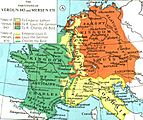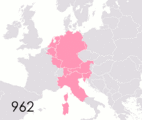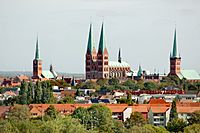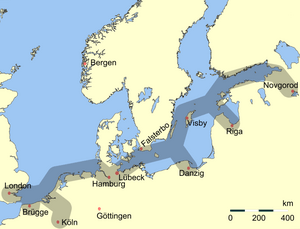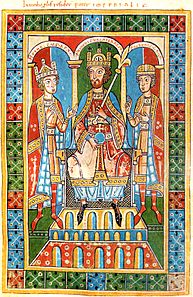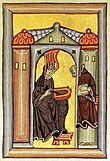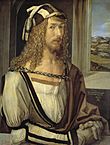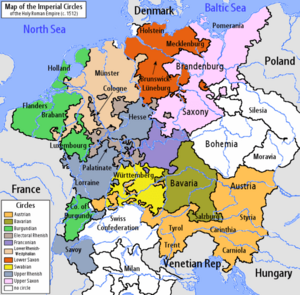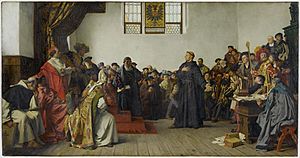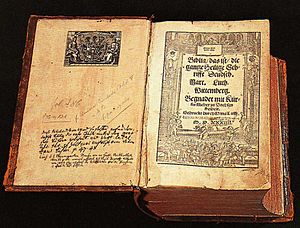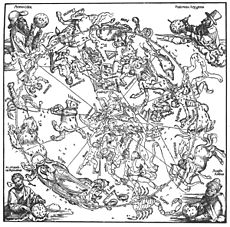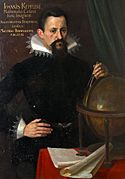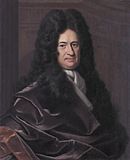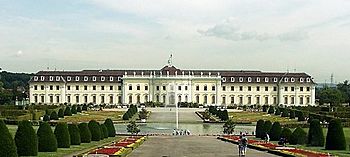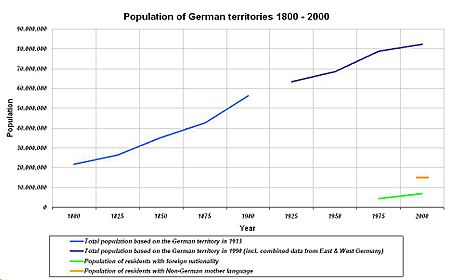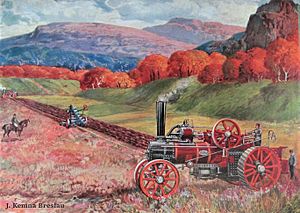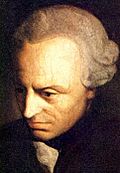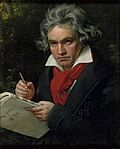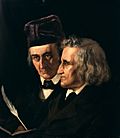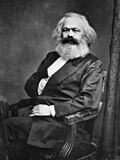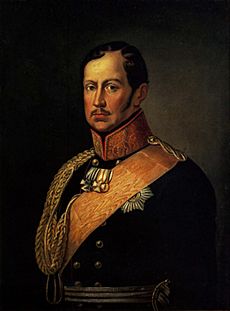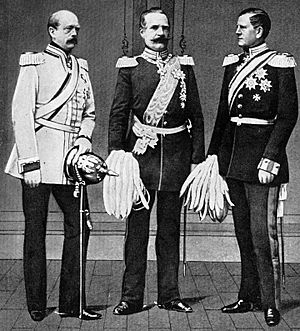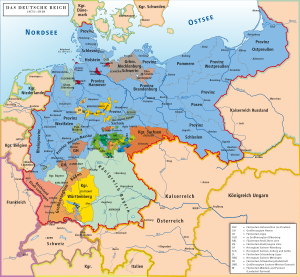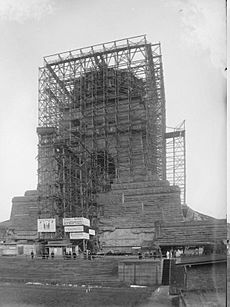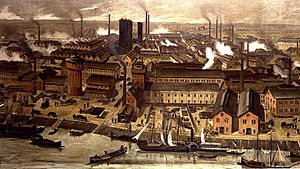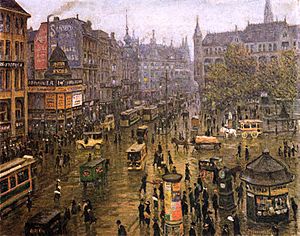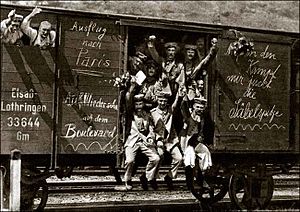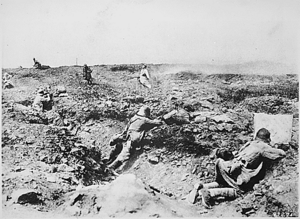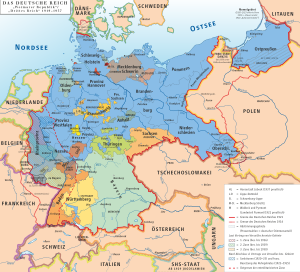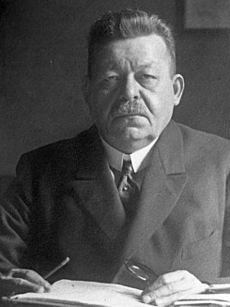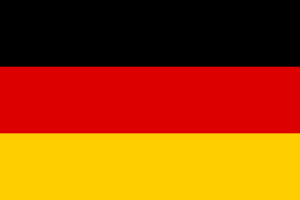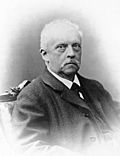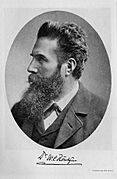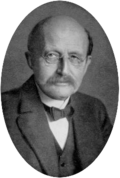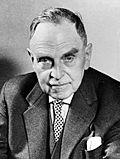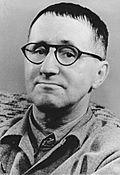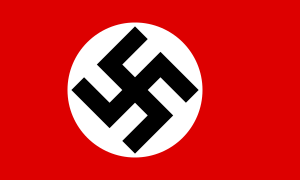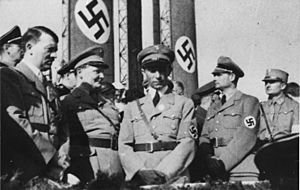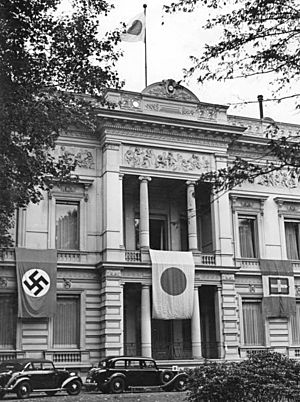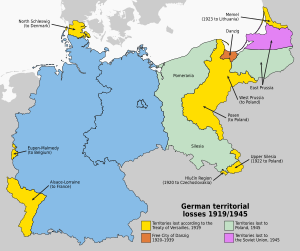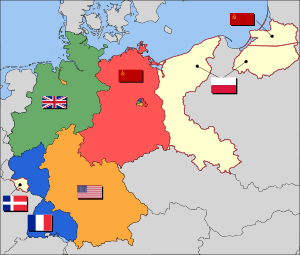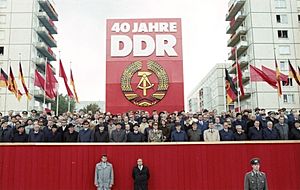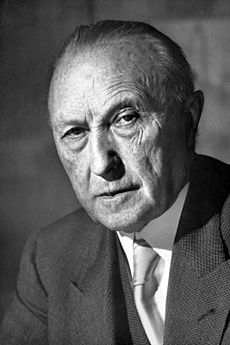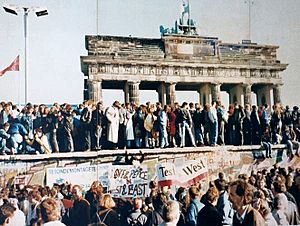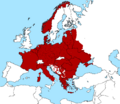History of Germany facts for kids
The land we know today as Germany has a long and exciting history, stretching back millions of years! It's located in the heart of Central Europe. The ancient Romans, led by Julius Caesar, called the area east of the Rhine River Germania. This was different from Gaul (modern France). Around 9 AD, brave Germanic tribes won a big battle against the Roman Empire in the Battle of the Teutoburg Forest. This stopped the Romans from taking over the whole area.
Later, after the Fall of the Western Roman Empire, the Franks became powerful. Their empire was split in 843, and the eastern part became East Francia. In 962, Otto I became the first Holy Roman Emperor, leading a medieval German state.
During the High Middle Ages, German port cities formed the Hanseatic League, a strong trading group that controlled the Baltic and North Seas. The Protestant Reformation, led by Martin Luther after 1517, changed religion in Germany forever. Many northern and eastern states became Protestant, while southern and western states stayed Catholic. A terrible conflict called the Thirty Years' War (1618–1648) caused huge destruction. After this war, many smaller states gained more power.
The Napoleonic Wars ended the old Holy Roman Empire in 1806. Napoleon created a new state called the Confederation of the Rhine. After Napoleon's defeat, the German Confederation was formed. The Industrial Revolution brought big changes, making the economy modern and cities grow fast. Prussia, with its capital Berlin, became very strong. German universities became famous for science and learning. Finally, in 1871, Germany was united under Chancellor Otto von Bismarck, forming the German Empire.
By 1900, Germany was a leading power in Europe. Its industry grew faster than Britain's. Germany led the Central Powers in World War I but was defeated. It lost land and colonies and had to pay for the war. The German Revolution of 1918–1919 ended the empire, and the Weimar Republic, a democracy, was created. However, it was unstable. In 1933, Adolf Hitler and the Nazi Party took control, creating a totalitarian regime. They focused on racism, especially against Jewish people, and became very aggressive. Germany quickly rebuilt its army, took over neighboring lands, and invaded Poland, starting World War II. During the war, the Nazis carried out the the Holocaust, a terrible plan to kill millions of people, including 6 million Jews. Germany was defeated in May 1945.
After the war, Germany was divided into West Germany (allied with NATO) and East Germany (allied with the Warsaw Pact). West Germany grew very fast economically. In 1989, the Berlin Wall was opened, and East and West Germany reunited in 1990. Today, Germany is a major economic power in Europe and a key member of the European Union. It has faced challenges like the European migrant crisis in 2015 and has recently decided to strengthen its armed forces after Russia's 2022 invasion of Ukraine.
Contents
- Ancient Times: Early Humans and Tribes
- Early History: Germanic Tribes and Romans
- Middle Ages: Empires and Leagues
- Early Modern Germany: Reformation and Wars
- 1648–1815: Rise of Prussia and Enlightenment
- 1815–1871: Confederation and Unification
- German Empire (1871–1918)
- Weimar Republic (1919–1933)
- Nazi Germany (1933–1945)
- Germany During the Cold War (1945–1990)
- Federal Republic of Germany (1990–Present)
- Images for kids
- See also
Ancient Times: Early Humans and Tribes
Pre-human ancestors, like the Danuvius guggenmosi, might have walked on two legs in Germany over 11 million years ago. Bones of early humans, Homo heidelbergensis, show people lived here at least 600,000 years ago. The oldest hunting weapons ever found, 380,000-year-old wooden spears, were discovered in Schöningen, Lower Saxony.
In 1856, fossilized bones of an extinct human species, now called Neanderthal man, were found near Düsseldorf. These fossils are about 40,000 years old.
Later, early modern humans (Homo sapiens) lived in caves in the Swabian Jura. They made amazing things like mammoth ivory sculptures, which are some of the oldest artworks. They also made flutes from bird bone and mammoth ivory, the oldest musical instruments ever found. The 40,000-year-old Löwenmensch figurine (Lion-Man) and the 35,000-year-old Venus of Hohle Fels are famous examples.

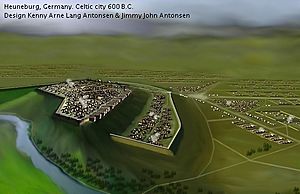
Around 10,000 to 8,000 years ago, the first farmers came to Europe from western Anatolia. Central Germany was a key area for early farming cultures. The oldest circular enclosures, like the Goseck circle, were built around 4900 BC. The first signs of wheels and wagons, dating to 3400 BC, were found in northern Germany.
Later, people of Indo-European origin arrived around 4,500 years ago. By the late Bronze Age, new cultures developed. The Hallstatt culture (12th to 8th centuries BC) and later the La Tène culture (5th to 1st centuries BC) were important.
People in central and southern Germany during this time are thought to be Celts. Some Celtic centers, like Heuneburg, became important trading hubs with the Mediterranean. Around 700 BC, Germanic peoples from southern Scandinavia and northern Germany began moving south, gradually replacing the Celts.
Early History: Germanic Tribes and Romans
Germanic Tribes and Roman Encounters
The Germanic tribes started expanding from their homes in southern Scandinavia and northern Germany around the 1st century BC. They met Celtic tribes and other cultures.
We learn about early Germanic history mostly from Roman writings, language studies, and archaeological finds. Around 60 BC, the Suebi tribe, led by Ariovistus, took over lands west of the Rhine. Julius Caesar defeated them in 58 BC, forcing Ariovistus back across the Rhine.
Roman Settlements Along the Rhine
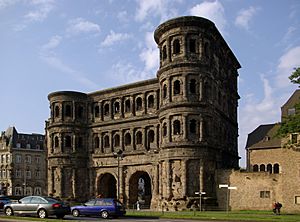
The first Roman emperor, Augustus, wanted to conquer lands beyond the Rhine and Danube rivers. Forts and trading posts were built along these rivers. Some tribes, like the Ubii, even allied with Rome and adopted Roman culture.
However, the Romans struggled to control the areas east of the Rhine. In 9 AD, a group of tribes led by the Cherusci chieftain Arminius defeated a large Roman army in the Battle of the Teutoburg Forest. After this, Rome decided to keep the Rhine/Danube as its permanent border. By 100 AD, the Limes Germanicus (a fortified border) was firmly in place. Christianity was introduced to western Germany under Roman rule before the Middle Ages.
Migration Period and Roman Decline
Around the 3rd century, large Germanic tribes like the Alamanni, Franks, and Saxons began moving beyond the Roman borders. These migrations played a part in the decline of the Roman Empire. By the late 4th century, the Huns invaded Europe, causing even more tribes to move, starting the Migration Period.
Early German Regions: Stem Duchies
In Germany, "stem duchies" were traditional areas of different Germanic tribes. These included Bavaria, Swabia, Saxony, Franconia, and Thuringia. These duchies were important divisions of Germany for a long time. Later, new border regions called "marches" were created in the east and north, like Brandenburg and Austria.
Middle Ages: Empires and Leagues
The Frankish Empire
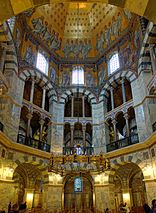
The Western Roman Empire fell in 476. The Franks, a group of Germanic tribes, became powerful. Clovis I united all the Frankish tribes by 500 and became their king. Unlike many other Germanic rulers, Clovis became a Roman Catholic, which helped him work closely with the Pope.
The Frankish kings conquered many areas, including parts of modern Germany. They put different regions under the control of dukes. The conquered tribes were encouraged to become Christian.

In 751, Pippin III became king of the Franks, supported by the Church. His son, Charles the Great (also known as Charlemagne), ruled from 774 to 814. He launched long wars against the Saxons and Avars, forcing them to become Christian and adding their lands to his empire. On Christmas Day in 800 AD, Charlemagne was crowned Emperor of the Romans in Rome.
Birth of the Holy Roman Empire
After Charlemagne's death, his grandsons divided his empire in 843 with the Treaty of Verdun. Louis the German received East Francia, the lands east of the Rhine. This area included the German stem duchies. These regions later united under Henry the Fowler (919–936). Royal courts moved between strongholds, which became important economic and cultural centers. Aachen Palace was central, with its chapel used for all royal coronations until 1531.
- The Holy Roman Empire, maps
-
The division of the Carolingian Empire in 843.
-
Territorial changes of the Holy Roman Empire from 962 to 1806.
-
The Holy Roman Empire at its largest under Frederick II, 13th century.
Otto the Great
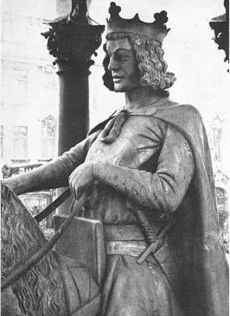
In 936, Otto I was crowned German king. In 962, he was crowned emperor by the Pope in Rome. This began the tradition of the German King protecting Italy and the Church, leading to the name Holy Roman Empire. Otto made the king's power stronger by controlling who became bishops and abbots, who owned a lot of land. He also defeated the Hungarian Magyars in 955.
Later, during the reign of Henry III (1039–1056), the empire supported Church reforms. However, the Pope, Pope Gregory VII, wanted full control over Church appointments. This led to a big conflict called the Investiture Controversy, where Emperor Henry IV had to humble himself before the Pope in 1077. This dispute ended in 1122, giving the Church more control over religious matters.
Between 1095 and 1291, the crusades to the Holy Land took place, and knightly religious groups like the Teutonic Knights were formed. The term Holy Roman Empire was officially used from 1157.
The Hanseatic League
The Hanseatic League was a powerful group of merchant guilds from northern and central European towns. It controlled sea trade in the Baltic Sea and North Sea from the 12th to 15th centuries. Cities like Lübeck and Hamburg worked together to protect trade routes, get tax benefits, and control prices.
The League became very strong, with trading posts across Europe, from London to Novgorod. By the late 14th century, it even used military force when needed, fighting a war with Denmark. Lübeck was the main city of the League. The League started to decline after 1450 due to various reasons, including changes in trade and politics.
Eastward Expansion

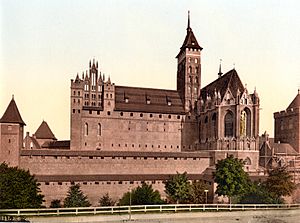
The Ostsiedlung (Eastern settlement) was a process where German people moved into lands east of the Saale and Elbe rivers, already inhabited by Slavs and Balts, from the 11th to 14th centuries. Early military campaigns aimed to control local tribes. Conquered areas were often turned into fortified borderlands.
New communities were set up under German law. The number of settlers was often small, and people usually blended together. In 1230, the Teutonic Knights, a Catholic group, started a campaign to Christianize the Baltic Old Prussians. They conquered large territories and created their own independent state. This state expanded for 150 years but faced conflicts with Poland and Lithuania, leading to military defeat by the mid-15th century. In 1525, the last leader of the Teutonic Order became a Protestant and turned the remaining lands into the secular Duchy of Prussia.
Church and State Power
Conflicts between emperors and the Church continued. Emperor Henry V tried to control the Church, leading to more disputes. In the 12th century, Germany was divided into two powerful groups: the Welfs (or Guelphs), who supported Church independence, and the Waiblings (or Ghibellines), who supported a strong emperor.
Under Emperor Frederick I (Barbarossa), a compromise was reached. However, cities in Northern Italy, supported by the Pope, resisted Barbarossa's rule. They defeated him in battle in 1176. This led to agreements that gave Italian cities more local power.
After Frederick I, the Hohenstaufen dynasty fell, leading to a period without an emperor (1250–1273). This ended with the election of Rudolf of Habsburg. In 1338, German princes declared that an emperor could be chosen without papal approval, making the monarch more dependent on the electors. The Golden Bull of 1356 set up a system where seven electors (four secular princes and three archbishops) would choose the emperor.
Between 1347 and 1351, the Black Death (a terrible plague) swept through Germany and Europe, killing many people. This led to social problems and attacks on minority groups, especially Jewish people, who were often blamed. Many Jews fled to Eastern Europe.
Towns and Cities Grow
By the end of the 11th century, Germany's population was around 5 to 6 million. Most people were farmers. Towns slowly grew, and many new cities were founded along trade routes and near castles. Cities like Cologne became Imperial Free Cities, meaning they were directly under the Emperor, not local lords, and had more freedom.
These towns were run by councils of wealthy merchants. Craftsmen formed guilds with strict rules. Society became more diverse, with different classes like clergy, merchants, artisans, and peasants.
Cologne, located on the Rhine River, became a major trade and transport hub. It was also the seat of an archbishop, and the huge Cologne Cathedral was built there, becoming a famous pilgrimage site. By 1288, Cologne gained independence from the archbishop and was ruled by its citizens.
Learning and Culture Flourish
Benedictine abbess Hildegard von Bingen (1098–1179) wrote important texts on theology, plants, and medicine. She also composed music and a morality play. About a century later, Walther von der Vogelweide became the most famous of the Minnesänger, who were lyric poets.
Around 1439, Johannes Gutenberg from Mainz invented the printing press with movable type. This started the Printing Revolution. Cheap printed books and pamphlets helped spread new ideas, including the Protestant Reformation and the Scientific Revolution.
Around the late 15th and early 16th centuries, Albrecht Dürer from Nuremberg became a famous painter, printmaker, and theorist, one of the most important artists of the Northern Renaissance.
- Influential German-speaking authors, artists and scholars
-
Hildegard von Bingen, abbess, philosopher, author.
-
Walther von der Vogelweide, famous poet.
-
Johannes Gutenberg, inventor of the printing press.
-
Albrecht Dürer, influential artist.
Early Modern Germany: Reformation and Wars
Social Changes and New Powers
After the problems of the 14th century, European society slowly changed. The rise of cities and a new middle class of merchants weakened the old feudal system. Wealthy families in southern German cities like Augsburg and Nuremberg, such as the Fuggers, became very rich. They lent money to rulers and influenced politics.
From 1438, the Habsburg family, who controlled Austria, Bohemia, and Hungary, usually held the title of Holy Roman Emperor until 1806.
New inventions like the first modern postal system and Gutenberg's printing press led to a communication revolution. This made it easier for people like Martin Luther to spread their ideas. Emperor Maximilian I also reformed the military, creating the Landsknechte, which changed warfare in Europe.
Imperial Reforms
During his reign (1493–1519), Emperor Maximilian I worked with different groups to reform the empire. They set up new courts, made the Imperial Diet (parliament) a key political body, and declared a permanent peace to stop internal wars. They also created Imperial Circles to help organize armies and collect taxes. These reforms helped keep the empire together. The term "German nation" became more common during this time.
The Protestant Reformation
In the early 16th century, the Popes were raising a lot of money by selling "indulgences" (pardons for sins). In 1517, a monk named Martin Luther published his 95 Theses. He criticized the sale of indulgences and other practices of the Catholic Church. His ideas spread quickly, helped by the new printing press.
The Protestant Reformation began in 1521 when Luther was declared an outlaw at the Diet of Worms for refusing to change his views. While hiding, Luther translated the Bible into German. This helped create the modern German language. Many German princes adopted Luther's ideas, leading to the establishment of the separate Lutheran church.
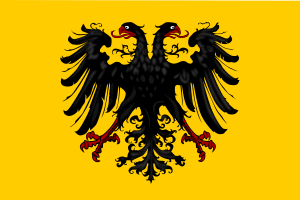
The German Peasants' War (1524–1525) was a series of revolts by peasants against their feudal lords, encouraged by radical reformers. The peasants were defeated, and many were killed.
The Catholic Church responded with the Counter-Reformation, led by the Jesuit order. In 1547, Emperor Charles V defeated an alliance of Protestant rulers. The Peace of Augsburg in 1555 allowed rulers to choose the official religion of their principality. However, the Counter-Reformation failed to bring the northern German states back to Catholicism. This led to the formation of Protestant and Catholic alliances in the early 17th century.
The Thirty Years' War (1618–1648)
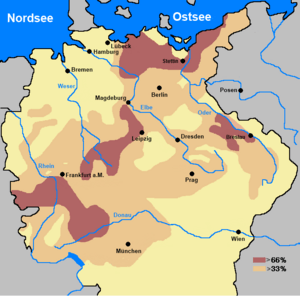
The Thirty Years' War was a devastating conflict fought almost entirely in the Holy Roman Empire. It started from religious conflicts between Catholics and Protestants. Emperor Ferdinand II wanted to unite the empire religiously and politically, but Protestants resisted. Other European powers joined the war to gain land and power.
The war caused immense destruction. Armies plundered the countryside, and food shortages were common. The population dropped dramatically due to killings, diseases, and famine. Some regions lost over a third of their people.
The war ended in 1648 with the Peace of Westphalia. This treaty gave more independence to the states within the Holy Roman Empire and limited the emperor's power. Parts of Germany were given to France and Sweden. This war was the last major religious conflict in Europe.
Culture and Literacy Grow
By the mid-16th century, Germany's population was about 20 million, mostly farmers. The Protestant Reformation boosted literacy and the use of the printing press. Luther's German Bible translation (New Testament in 1522, Old Testament completed in 1534) was very popular. It helped increase literacy and shaped the modern German language.
From 1517, religious pamphlets flooded Germany. Luther's writings, like his Small Catechism, helped spread his ideas. Artists like Lucas Cranach the Elder illustrated Luther's theology for a wider audience.
Science and Learning Flourish
Many brilliant thinkers lived in Germany during this period. Johannes Trithemius helped found modern cryptography. Conrad Celtes was a key figure in German humanism. Athanasius Kircher was a polymath who contributed to geology, musicology, and more. Gottfried Wilhelm Leibniz was a "Universal genius" in philosophy and mathematics.
Cartography (map-making) developed strongly in Nuremberg. Martin Waldseemüller and Matthias Ringmann created important world maps. In 1515, Johannes Stabius, Albrecht Dürer, and Konrad Heinfogel produced the first printed celestial maps.
Astronomer Johannes Kepler (1571–1630) from Weil der Stadt developed his laws of planetary motion through careful research. His ideas influenced Galileo Galilei and provided principles for Isaac Newton's theory of universal gravitation.
- Scientists, scholars and artists of Early Modern Germany
-
Johannes Kepler, astronomer and mathematician.
-
Otto von Guericke, scientist and inventor.
-
Gottfried Wilhelm Leibniz, philosopher and mathematician.
German Colonies in the Americas
German colonies existed in the Americas because the cities of Augsburg and Nuremberg received colonial rights in Venezuela. This was in exchange for debts owed by Emperor Charles V. In 1528, the Welser family was given rights to explore and colonize the area, hoping to find the legendary golden city of El Dorado. Their main colony was Klein-Venedig.
1648–1815: Rise of Prussia and Enlightenment
Prussia Becomes a Great Power
Frederick William, known as the Great Elector, ruled Brandenburg-Prussia from 1640. He gained East Pomerania in 1648. He organized his lands and freed Prussia from Polish control. He encouraged French Huguenots to settle in urban areas, bringing skilled craftsmen and entrepreneurs.
King Frederick William I (1713–1740), the Soldier King, built a highly centralized Prussian state and a strong professional army. He also managed the economy carefully.
Germany's population grew from 16 million in 1700 to 24 million in 1800. The economy benefited from new scientific methods, leading to better farming and health.
Wars and Conflicts

Louis XIV of France fought several wars to expand French territory, taking over Lorraine and parts of Alsace. He invaded the Electorate of the Palatinate in 1688. Louis's forces were largely unopposed because imperial troops were fighting the Great Turkish War in Austria. The Grand Alliance formed against France, and the conflict ended in 1697, with some lands returned to the empire.
After the Battle of Vienna in 1683, European forces pushed back the Ottoman Empire. Prince Eugene of Savoy led Austrian forces to decisive victories, ending Turkish rule over much of the Balkans by 1718.
Enlightened Absolutism
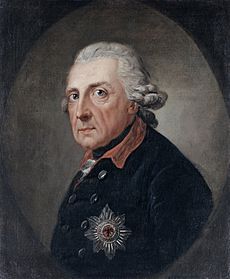
Frederick II "the Great" (1740–1786) was known for his military skills, making Prussia a great power. He also believed in enlightened absolutism, where the ruler uses absolute power for the good of the people. He made legal reforms (like ending torture), reorganized the Prussian Academy of Sciences, introduced compulsory education, and promoted religious tolerance.
Austrian empress Maria Theresa fought to keep her throne (1740–1748) but lost Silesia to Prussia. The Seven Years' War (1756–1763) confirmed Prussia's status as a major European power. This led to the "German dualism," a rivalry between Austria and Prussia for power in Central Europe.
Prussia, Austria, and Russia also divided Poland among themselves between 1772 and 1795, causing Poland to disappear as a sovereign state until 1918.
Smaller German States
Smaller German states were less powerful. Bavaria had a rural economy. Saxony was economically strong but focused on trying to gain the Polish throne.
Many small states were run by bishops from noble families. Some, like Franz Ludwig von Erthal in Würzburg, promoted Enlightenment ideas. In Hesse-Kassel, Frederick II (1760–1785) ruled as an enlightened despot. He raised money by renting soldiers (called "Hessians") to Great Britain for the American Revolutionary War.
Hanover was ruled by the kings of England, so it didn't have a lavish court. Its University of Göttingen became a world-class intellectual center. Baden had a good government under Karl Friedrich, who abolished serfdom in 1783. These smaller states often failed to unite and were eventually absorbed by Prussia.
Social Changes in Prussia
Prussia saw big social changes from the mid-17th to mid-18th centuries. The traditional nobility struggled against the rising merchant class, which became a new middle class. Peasants gained land rights and freedom of movement, and farming reforms led to wealthier peasants and a more efficient rural economy.
The Enlightenment in Germany
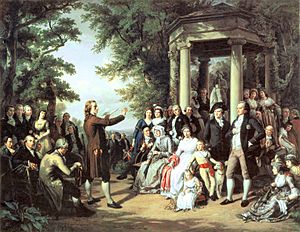
From the mid-18th century, Enlightenment ideas led to higher quality art, music, philosophy, science, and literature. Philosopher Christian Wolff helped make German the language of philosophical and scholarly thought.
In 1685, Frederick William of Prussia welcomed French Huguenots (Protestants) who were being persecuted. Thousands settled in Berlin, bringing skills and French language, which became common in diplomacy. Prussia used Enlightenment ideas to develop better political and administrative systems.
Johann Gottfried von Herder was a leader of the Sturm und Drang (Storm and Stress) movement, which emphasized emotion. Weimar Classicism, involving Herder, Johann Wolfgang von Goethe, and Friedrich Schiller, sought to combine Romantic, classical, and Enlightenment ideas. Herder argued that each people had its own identity, expressed in language and culture, which helped shape German nationalism.
German music flourished with composers like Johann Sebastian Bach, Joseph Haydn, and Wolfgang Amadeus Mozart. Philosopher Immanuel Kant tried to combine reason and religious belief. His work greatly influenced European thought.
French Revolution and Napoleon (1789–1815)
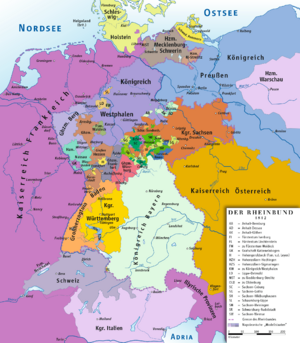
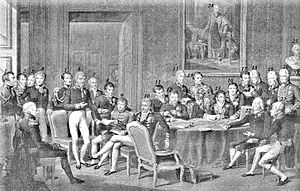
German reactions to the French Revolution were mixed. Intellectuals initially celebrated, hoping for reason and enlightenment. But after the French king was executed and the "Terror" began, many became disillusioned.
Europe was at war for two decades as France tried to spread its revolutionary ideas. In 1792, Austria and Prussia invaded France but were defeated. German lands saw armies moving back and forth, bringing destruction but also new ideas of liberty. Prussia and Austria later divided Poland with Russia.
French Control and the End of the Holy Roman Empire
France took control of the Rhineland, bringing French-style reforms like abolishing feudalism, establishing constitutions, and promoting religious freedom. These reforms modernized western Germany. When the French tried to impose their language, German resistance grew.
Napoleon abolished the old Holy Roman Empire in 1806. He created the "Confederation of the Rhine" as a group of German states under his control, excluding Prussia and Austria.
Under Frederick William II, Prussia had declined. His successor, Frederick William III, tried to stay neutral but joined the war against Napoleon in 1806. Napoleon easily defeated the Prussian army and occupied Berlin. Prussia lost territory and had to pay high costs. Saxony switched sides to support Napoleon.
After Napoleon's huge defeat in Russia in 1812, Prussia allied with Russia and Austria. Napoleon was defeated at the Battle of Leipzig in 1813. The German states turned against Napoleon. Coalition forces invaded France, and Napoleon surrendered in 1814. Prussia gained a lot of territory at the Congress of Vienna.
1815–1871: Confederation and Unification
A New German Order
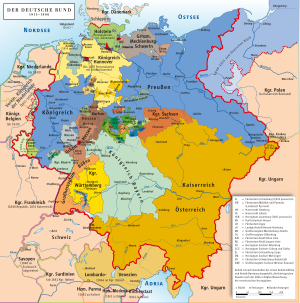
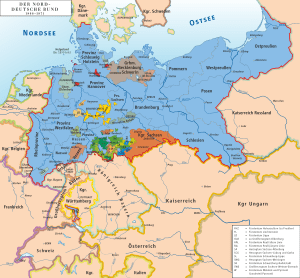
After Napoleon's fall, European leaders met in Vienna in 1815 to reorganize Europe. They wanted a stable Germany to prevent French aggression. The idea of bringing back the Holy Roman Empire was dropped. Instead, the German Confederation was formed, a loose union of 39 states under Austrian leadership. This union was weak and didn't satisfy German nationalists. It was replaced by the North German Confederation in 1866 after a war between Austria and Prussia.
Society and Economy Change
After 1815, the Prussian government in Berlin gained more power over the nobles. Prussia also helped nobles and peasants with loans. By 1871, the Junker nobility controlled the army, bureaucracy, and royal court, influencing government policies.
Population Growth
Between 1815 and 1865, Germany's population (excluding Austria) grew by about 60%, from 21 million to 34 million. Farming became more productive, providing enough food and reducing famines. This led to more births, but also high infant mortality. After 1840, many Germans moved to the United States.
Industrial Revolution in Germany
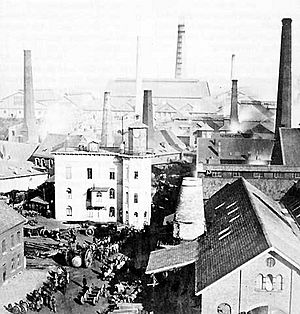
In 1800, Germany's economy wasn't ready for industrial growth. But French rule (1790s–1815) brought reforms like ending feudal restrictions and reducing guild power.
The Industrial Revolution was already happening in Britain and France. Germany's small states developed slowly at first. Early railway investments in the 1830s came from private sources. Real industrialization took off after 1850 with railway construction. The textile industry grew fast. By 1900, Germany was a world leader in industry, along with Britain and the United States.
Cities Grow
In 1800, most Germans lived in rural areas. But after 1815, cities grew rapidly as young people moved from the countryside. Berlin's population soared from 172,000 in 1800 to 826,000 in 1870.
Railways Connect Germany
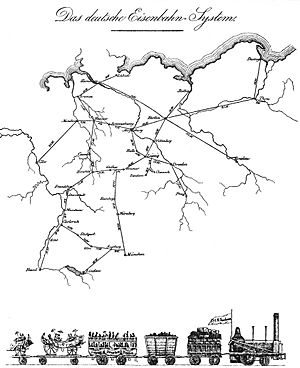
The railway revolution in the 1840s was key for economic development. It opened new markets, created jobs for managers and engineers, and boosted demand for coal and iron. Despite political divisions, major railway lines linked cities by the 1840s. Each German state built lines within its borders.
Economist Friedrich List (1841) highlighted the benefits of railways: they helped national defense, improved culture by connecting people, prevented food shortages, and united the nation. At first, Germany imported technology from Britain. But by 1850, Germany could build its own railways, which greatly helped the new steel industry. After German unification in 1870, railways grew even faster, supporting industrialization.
Newspapers and Magazines
Germany had many regional newspapers, but no single national one. Only a small percentage of educated men read them. Censorship was strict, and the government controlled political news. After 1871, Bismarck used strict press laws against socialists. Magazines were more influential and attracted intellectual writers.
Science and Culture in the 19th Century
19th-century artists and thinkers were inspired by the French Revolution and writers like Johann Wolfgang von Goethe, Gotthold Ephraim Lessing, and Friedrich Schiller. The Romantic movement emphasized emotion. Immanuel Kant's philosophy changed how people thought.
Ludwig van Beethoven was a highly influential composer, bridging classical and romantic music. In opera, Richard Wagner perfected a new Romantic style. The Brothers Grimm collected folk stories like Grimm's Fairy Tales and started work on the comprehensive Deutsches Wörterbuch (German Dictionary).
German universities became world leaders, especially in history and language studies. Famous philosophers included Georg Wilhelm Friedrich Hegel, Friedrich Nietzsche, and Karl Marx. The University of Berlin, founded in 1810, became a top university. Scientists like Alexander von Humboldt (natural science) and Carl Friedrich Gauss (mathematics) gained international fame.
- 18th- and 19th-century German artists, scientists and philosophers
Religion in Change
Two main changes shaped religion in Germany. There was a movement to unite the Lutheran and Reformed Protestant churches. In Prussia, King Frederick William III (1797–1840) tried to unify Protestant churches and impose a single way of worship. This led to the Church of the Prussian Union. Some "Old Lutherans" resisted and were persecuted, with many moving to the United States.
For Catholics and Protestants, religion became more personal. Pietistic revivals were common among Protestants. Catholics saw a rise in pilgrimages. The Vatican gained more control over German Catholic bishops. A conflict arose in the Rhineland over how children of mixed marriages should be raised. This led to a strong sense among Catholics that they needed to stick together.
Politics: Restoration and Revolution
After Napoleon's Defeat
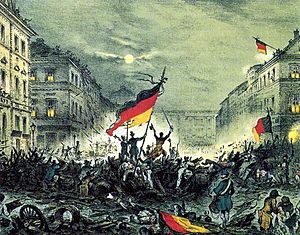
After Napoleon, European leaders met at the Congress of Vienna in 1815. They wanted to restore old rulers and suppress revolutionary ideas. The German Confederation was formed, a loose union of 39 states under Austrian leadership. It was weak and didn't satisfy nationalists.
In 1819, a student killed a playwright who mocked liberal students. This led to the repressive Carlsbad Decrees, which banned student groups, removed liberal professors, and increased censorship. Many people accused of spreading revolutionary ideas were persecuted.
In 1834, the Zollverein, a customs union, was formed between Prussia and most other German states, but not Austria. As industry grew, the need for a unified German state with one currency and legal system became clear.
The 1848 Revolutions
Growing unhappiness with the political system led to the March Revolution in 1848. In May, the German National Assembly (the Frankfurt Parliament) met in Frankfurt to write a German constitution.
However, the revolution failed. King Frederick William IV of Prussia refused the imperial crown, the parliament was dissolved, and rulers used military force to stop uprisings. The German Confederation was re-established by 1850. Many leaders went into exile, some to the United States.
Bismarck Takes Charge (1862–1866)
In 1861, William I became King of Prussia. In 1862, he appointed Otto von Bismarck as Prussian minister president. Bismarck, along with Defense Minister Albrecht von Roon and Field Marshal Helmut von Moltke, led Prussia to military victories that unified Germany.
In 1863–1864, Prussia and Denmark fought over Schleswig. Prussia, joined by Austria, easily defeated Denmark. This led to tensions between Austria and Prussia over how to manage the conquered territories. This disagreement became the reason for the Seven Weeks War in 1866. Prussia's better logistics and modern rifles led to a decisive victory over Austria. This battle decided the struggle for power in Germany, with Prussia becoming dominant.
North German Confederation (1866–1871)
After the Seven Weeks War, the German Confederation was dissolved. The North German Federation was formed under Prussia's leadership. Austria was excluded, ending its influence over Germany. This federation was a temporary step before the German Empire was founded.
German Empire (1871–1918)
Overview of the Empire
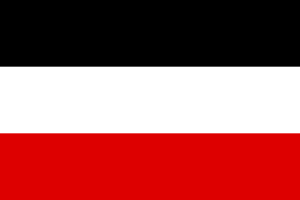
Chancellor Otto von Bismarck guided the German Empire until 1890. He formed alliances in Europe to isolate France and increase Germany's influence. At home, he tried to suppress socialism and reduce the Catholic Church's power. He introduced social laws like health care and pensions. His Kulturkampf (culture struggle) against Catholics was strongly resisted. By 1900, German industry and economy matched Britain's.
In 1888, the young Emperor Wilhelm II took the throne. He dismissed Bismarck in 1890 and pursued aggressive colonial policies, wanting Germany to have an empire like Britain and France. He started a dangerous naval arms race with Britain. His policies contributed to the outbreak of World War I.
The Bismarck Era
The New Empire is Born
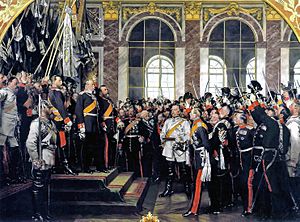
In 1870, a diplomatic incident led to the Franco-Prussian War. Prussia, with its German allies, quickly defeated France. French Emperor Napoleon III was captured, and Paris was besieged. France was forced to pay a large sum and give Alsace-Lorraine to Germany. This deeply humiliated France.
During the Siege of Paris, German princes gathered at the Palace of Versailles on January 18, 1871. They announced the creation of the German Empire and proclaimed Prussian King Wilhelm I as German Emperor. This act united all German states (except Austria) into a federal unit. Bismarck became Chancellor.
A Federal Empire
The new empire was a union of 25 states, varying greatly in size and culture. Prussia made up two-thirds of the territory and population. However, even Prussia had internal divisions. People in western provinces, who had benefited from French liberal reforms, felt different from those in rural eastern Prussia.
Many people in smaller states, especially in central and southern Germany, didn't like the "Prussianized" idea of the nation. Hanseatic port cities like Hamburg strongly opposed Prussian militarism and economic integration.
Bismarck's domestic policies aimed to make the Protestant Prussian state's ideas universal and separate church and state. In the Kulturkampf (1871–1878), he tried to reduce the influence of the Roman Catholic Church and its political party, the Catholic Centre Party. He secularized education and introduced civil marriage. However, Catholics strongly resisted, and the Center Party gained power. Bismarck eventually abandoned the Kulturkampf. Non-German minorities, like Poles and Danes, faced discrimination.
Social Classes: Aristocracy, Middle Class, and Workers
The new Empire offered good careers for nobles in government and the army. Nobles controlled the civil service, universities, and churches. The military was very powerful and seen as upholding the nation.
The middle class in cities grew fast but didn't have as much political power as in other countries. Women's organizations, like the Association of German Women's Organizations (BDF), worked for equality in education and opportunities.
The Socialist Workers' Party (later Social Democratic Party of Germany, SPD) grew, aiming for a socialist society peacefully. Bismarck tried to stop them with Anti-Socialist Laws (1878), banning their organization and newspapers. But the Social Democrats still grew stronger. Bismarck then started social welfare programs in 1883, including old age pensions, accident insurance, and medical care, to gain working-class support and reduce emigration. These programs formed the basis of the modern European welfare state.
Foreign Policies and Alliances
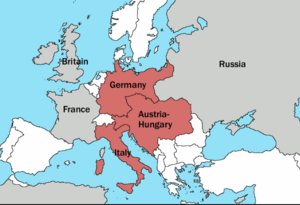
Bismarck's foreign policy focused on security and preventing a French-Russian alliance. He formed the League of Three Emperors in 1873 with Russia and Austria. In 1879, Germany formed the Dual Alliance with Austria-Hungary for mutual military help against Russia. Russia then signed the Reinsurance Treaty with Germany in 1887. In 1882, Italy joined the Dual Alliance, creating the Triple Alliance.
Bismarck initially opposed overseas colonies, but eventually agreed. Germany established colonies in Africa (Togo, Cameroons, German South-West Africa, German East Africa) and Oceania (German New Guinea). Bismarck organized the Berlin Conference of 1885, where European powers set rules for acquiring African territory, leading to the "Scramble for Africa."
The Wilhelminian Era (1888–1918)
Emperor Wilhelm II

Emperor William I died in 1888. His son, Frederick III, reigned only for 99 days before dying. His 29-year-old son, Wilhelm II, became emperor. Wilhelm rejected his parents' liberal ideas and ruled as an autocrat. In March 1890, he forced Bismarck to resign. Wilhelm wanted to have a strong influence on all government matters.
Alliances and Diplomacy Shift
Wilhelm II pursued an aggressive Weltpolitik ("world politics") to increase Germany's global influence. He refused to renew the Reinsurance Treaty with Russia. Russia then formed a closer alliance with France in 1894. Anglo-German relations worsened, especially due to Wilhelm's aggressive imperial ambitions and the naval arms race. Germany became increasingly isolated, relying on the Triple Alliance with Austria-Hungary and Italy. Italy later left this alliance in 1915.
In 1897, Admiral Alfred von Tirpitz planned to build a large naval force. Wilhelm fully supported this, believing a strong navy would force Britain to make diplomatic compromises. Germany traded Zanzibar with Britain for Heligoland in 1890, turning it into a naval base. Britain saw Germany's naval buildup as a threat and continued the naval arms race, introducing the advanced Dreadnought battleship in 1907.
Germany nearly clashed with Britain and France during the First Moroccan Crisis (1905) and Second Moroccan Crisis (1911) over Morocco. In both cases, Germany's aggressive stance led to diplomatic isolation, with other European powers siding against it.
Economic Growth
By 1890, Germany's economy continued to industrialize and grow rapidly, especially leading up to World War I. Industrial production increased by about 500% between 1870 and 1914.
Farmers adopted modern methods, like using artificial fertilizers, making Germany Europe's most efficient agricultural producer by 1914. However, farms were often small, and many relied on migrant workers.
German research laboratories led the way in chemical research, developing new equipment and team research methods. Germany became the world leader in the Chemical industry by the late 19th century, producing almost 90% of global dyes by 1913.
Germany also became Europe's leading steel producer in the 1890s. Firms like Krupp dominated. German companies often avoided fierce competition by forming trade associations, which helped regulate the market and allowed smaller firms to thrive.
Colonial Expansion

By the 1890s, German colonial expansion in Asia and the Pacific (like Kiauchau in China and Samoa) caused friction with other powers. The construction of the Baghdad Railway, financed by German banks, also conflicted with British and Russian interests.
Germany's largest colonies were in Africa. The harsh treatment of the Nama and Herero in Namibia (1906–1907) led to accusations of genocide. Historians are still studying the connections between this event and the later Holocaust.
World War I (1914–1918)
Causes of the War
Ethnic groups wanting their own nations upset the balance of power in Europe, leading to World War I in August 1914. Germany supported its ally Austria-Hungary against Serbia. But Serbia was protected by Russia, which was allied with France. Germany led the Central Powers (Austria-Hungary, Ottoman Empire, Bulgaria), while the Allies included Russia, France, Britain, and later Italy.
Britain joined the war because it feared Germany's growing economic and military power. British leaders worried that if Germany defeated France, it would control the English Channel and northwest France, which would be a disaster for British security.
Western Front Warfare
In the west, Germany tried for a quick victory by attacking Paris using the Schlieffen Plan. But Belgian resistance, troop diversions, and strong French defense on the Marne River stopped them. The Western Front became a bloody stalemate of trench warfare from 1914 to 1918. Battles moved only short distances along a line from the North Sea to Switzerland.
The British navy imposed a tight blockade in the North Sea, cutting off Germany's imports of raw materials and food. Food shortages became a serious problem by 1917. The United States joined the Allies in April 1917 after Germany declared unrestricted submarine warfare. This was a turning point against Germany.
Eastern Front Battles
Fighting on the Eastern Front was more open. Germany won decisive victories against the Russian army, trapping and defeating large parts of it at the Battle of Tannenberg. The collapse of Russian forces, made worse by the 1917 Russian Revolution, led to the Treaty of Brest-Litovsk in March 1918. Russia withdrew from the war, giving Germany control of Eastern Europe.
1918: The Final Push
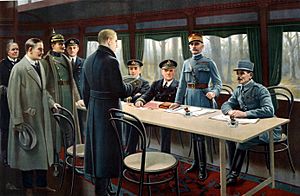
By defeating Russia, Germany moved hundreds of thousands of troops to the Western Front, gaining a numerical advantage. They hoped to win a decisive victory before the American army arrived in force. However, their spring offensives failed. By summer, with American troops arriving daily and German reserves exhausted, the Allies launched multiple offensives that destroyed the German army.
The Homefront Suffers
Germany quickly mobilized its economy for war, but the British blockade caused severe food shortages in cities. Many farmers went to war, transport systems were strained, and coal was scarce. The winter of 1916–1917 was called the "turnip winter" because turnips, usually for livestock, were eaten by people due to potato and meat shortages. Morale sank among civilians and soldiers.
The deadly 1918 Spanish Flu pandemic hit a population already weakened by years of malnutrition.
The 1918 Revolution
In late October 1918, the German Revolution of 1918–1919 began in Wilhelmshaven when navy units refused to sail for a final operation. The revolt spread, and workers' and soldiers' councils were formed. The Kaiser and all German rulers abdicated. On November 9, 1918, the Social Democrat Philipp Scheidemann proclaimed a Republic.
On November 11, the Compiègne armistice was signed, ending the war. The Treaty of Versailles was signed on June 28, 1919. Germany had to give up Alsace-Lorraine to France, and other territories to Belgium, Poland, and Lithuania. All German colonies were given to the League of Nations. The Rhineland was demilitarized, and the Saarland was put under League of Nations control for 15 years. The German army was limited to 100,000 men, and no military aircraft were allowed. Germany also had to pay reparations for war damages.
Weimar Republic (1919–1933)
Overview of the Republic
The harsh terms of the Treaty of Versailles angered many Germans and weakened the new democratic government. In December 1918, the Communist Party of Germany (KPD) was founded and tried to overthrow the republic in 1919, but failed. Adolf Hitler took control of the new National Socialist German Workers' Party (NSDAP) in 1919, which also failed in a coup attempt in Munich in 1923. Both parties had militant groups that fought in the streets.
Support for these extreme parties grew after 1929 when the Great Depression caused high unemployment. The Nazis (NSDAP) gained power in 1933 by appearing to work within the Weimar constitution. They ruled Germany from 1933 to 1945.
The Early Years of Weimar
The Weimar constitution came into effect on August 11, 1919, with Friedrich Ebert as the first President.
The Communist Party of Germany was founded in December 1918 and rejected the parliamentary system. In March 1920, right-wing politicians attempted a coup (the Kapp Putsch) but failed due to popular opposition.
Germany was the first country to establish diplomatic relations with the new Soviet Union in 1922. They agreed to cancel pre-war debts and cooperate.
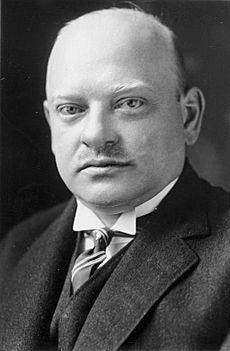
When Germany couldn't pay its reparations, French and Belgian troops occupied the industrial Ruhr district in January 1923. The German government encouraged passive resistance, which made the occupation costly for the French but also fueled hyperinflation. Many people lost all their savings and became enemies of the Republic.
In September 1923, Chancellor Gustav Stresemann ended passive resistance and introduced a new currency, the Rentenmark, to stop hyperinflation. The economy improved for the next six years, with industrial production reaching pre-war levels by 1928.
In 1925, Field Marshal Paul von Hindenburg was elected President.
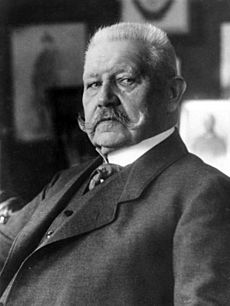
In October 1925, the Treaty of Locarno was signed, recognizing Germany's borders with France and Belgium. This paved the way for Germany to join the League of Nations in 1926.
Reparations and Economic Collapse
Germany's actual reparations payments from 1920 to 1931 were about 20 billion German gold marks, mostly from loans. This was much less than the initial high figures often discussed.
The Wall Street Crash of 1929 started the worldwide Great Depression, which hit Germany hard. By early 1932, over 6 million people were unemployed.
This economic crisis led to political problems. The proportional representation system meant many small parties couldn't form a stable government. Extremist parties, like the Nazis and Communists, grew stronger. In March 1930, President Hindenburg appointed Heinrich Brüning as Chancellor, allowing him to rule by emergency decrees, bypassing Parliament.
In the 1932 national elections, the Nazi Party became the largest party in the Reichstag, though without a majority. On January 30, 1933, President Hindenburg appointed Hitler as Chancellor.
Science and Culture in the Early 20th Century
The Weimar years saw a flourishing of German science and culture. German scientists won many Nobel Prizes. Germany led the world in physics before 1933, with figures like Albert Einstein, Max Planck, and Werner Heisenberg. Chemistry was also dominated by German professors and companies like BASF and Bayer, with scientists like Fritz Haber and Emil Fischer.
Key figures in engineering included Karl Benz (inventor of the automobile) and Rudolf Diesel. In microbiology, Ferdinand Cohn, Robert Koch, and Rudolph Virchow were important.
Important German writers included Thomas Mann, Hermann Hesse, and Bertolt Brecht.
After 1933, the Nazi regime attacked "Jewish physics" and forced many renowned scientists and writers, including Einstein, to flee Germany.
- 19th and 20th century German authors, scientists and philosophers
Nazi Germany (1933–1945)
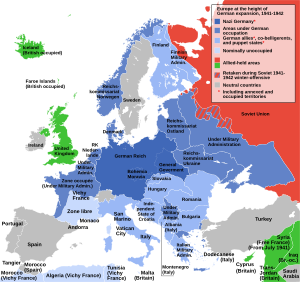
The Nazi regime suppressed labor unions and strikes, leading to economic growth that made the Nazi Party popular. There was little organized resistance. The Gestapo (secret police) crushed political opposition and persecuted Jews. The Nazis controlled courts, local government, and all civic groups except Christian churches. Propaganda, films, and rallies were used to control public opinion. Hitler was idolized as the Führer (leader), holding all power.
Establishment of Nazi Rule
After the Reichstag fire on February 27, 1933, Hitler blamed a supposed Communist uprising. He convinced President Hindenburg to approve the Reichstag Fire Decree, which removed civil liberties. Thousands of Communists were arrested, and their activities were banned. They were sent to new Nazi concentration camps.
In the last free general elections on March 5, 1933, the Nazis got 43.9% of the votes, not a majority. But with another party, they formed a slim majority. On March 23, 1933, the Enabling Act was passed, allowing Hitler and his cabinet to make laws without the President or Parliament. This act established the dictatorship. Trade unions and all political parties except the Nazi Party were suppressed. Germany withdrew from the League of Nations.
Hitler used the SS and Gestapo to eliminate his political enemies in the Night of the Long Knives (June 30 – July 2, 1934). After Hindenburg's death on August 2, 1934, Hitler combined the roles of President and Chancellor, becoming the sole head of state.
Antisemitism and the Holocaust
The Nazi regime was extremely hostile towards Jewish people, targeting them with constant antisemitic propaganda. In March 1933, they imposed a nationwide boycott of Jewish businesses. The first Nazi concentration camp was set up at Dachau. The Nuremberg Laws (1935) banned marriage between Jews and Germans and stripped Jews of their citizenship rights. Jews continued to suffer persecution, including the Kristallnacht pogrom in 1938. About half of Germany's 500,000 Jews fled before 1939.
In 1941, the Nazi leadership decided on the "Final Solution" – the Holocaust. This was a plan to systematically murder Jews and other "lesser races" and political opponents. Between 1941 and 1945, approximately 17 million people were killed, including 6 million Jews, 3 million Soviet prisoners of war, 2 million ethnic Poles, and hundreds of thousands of Roma, disabled people, homosexuals, and others.
Military Buildup
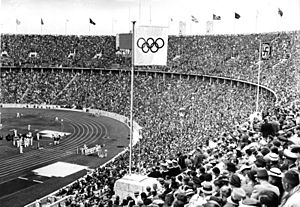
In 1935, Hitler officially re-established the Luftwaffe (air force) and brought back universal military service, breaking the Treaty of Versailles. In 1936, German troops marched into the demilitarized Rhineland. Britain and France did not intervene. This strengthened Hitler's position in Germany. The 1936 Summer Olympics in Berlin were also a great propaganda success for the regime.
Foreign Policy Aggression
In the 1930s, Hitler's strategy was to make demands, threatening war if they weren't met. When opponents tried to appease him, he took what was offered and moved to the next target. Germany left the League of Nations, rejected the Versailles Treaty, and re-armed. It remilitarized the Rhineland, allied with Italy, and sent aid to Franco in the Spanish Civil War.
On March 12, 1938, German troops marched into Austria, which was then annexed. Hitler was greeted with cheers in Vienna. After Austria, Hitler turned to Czechoslovakia, demanding that the Sudeten German minority be given self-government. At the Munich Conference in September 1938, Hitler, Mussolini, British Prime Minister Neville Chamberlain, and French Prime Minister Édouard Daladier agreed to give Sudeten territory to Germany. Hitler claimed this was his last territorial demand. However, six months later, he took over the rest of Czechoslovakia and then reclaimed Memel from Lithuania. Chamberlain realized his policy of appeasement had failed.
Hitler then formed a peace pact with the Soviet Union and finally invaded Poland on September 1, 1939. Britain and France declared war on Germany, starting World War II.
World War II (1939–1945)
At first, Germany was very successful. In less than three months (April–June 1940), Germany conquered Denmark, Norway, the Low Countries, and France. Hitler offered peace to Britain, but Winston Churchill refused. Hitler's bombing campaign against Britain (1940–1941) failed.
Germany's armed forces invaded the Soviet Union in June 1941, advancing close to Moscow. The Einsatzgruppen (Nazi mobile death squads) murdered Soviet Jews.
The war turned in December 1941 when the invasion of the Soviet Union met strong resistance in the Battle of Moscow, and Hitler declared war on the United States after the Japanese Pearl Harbor attack. After losing in North Africa and the Battle of Stalingrad (1942–1943), Germany was forced to defend. By late 1944, the Allies were closing in from the West, and the Soviets were advancing from the East.

In 1944–1945, Soviet forces liberated many Eastern European countries. Nazi Germany collapsed as Berlin was taken by the Soviet Red Army in a fierce battle. Hitler took his own life on April 30, 1945. The final German Instrument of Surrender was signed on May 8, 1945, ending Nazi Germany.
By September 1945, Nazi Germany and its allies were defeated. Over 60 million people worldwide were killed, including approximately 6 million Jews and 11 million non-Jews in the Holocaust. World War II destroyed Germany's infrastructure, led to its division, and caused significant loss of territory.
Germany During the Cold War (1945–1990)
After its defeat in 1945 and the start of the Cold War in 1947, Germany was divided. Millions of refugees from Central and Eastern Europe moved to West Germany. Two countries emerged: West Germany (a democracy, NATO member, and founding member of the European Union) and East Germany (a Communist dictatorship controlled by the Soviet Union). When Communism collapsed in 1989, Germany was reunited.
Expulsion of Germans
At the Potsdam Conference, Germany was divided into four military occupation zones by the Allies. It didn't regain independence until 1949. Provinces east of the Oder and Neisse rivers were given to Poland and Soviet Russia. The Saarland became a French protectorate. Most of the remaining German population in these areas was expelled. Around 6.7 million Germans from Poland and 3 million from Czechoslovakia were forced to move west.
Post-War Chaos and Recovery
Between 5.5 and 7 million Germans died in the war. There was chaos as 11 million foreign workers and prisoners of war left, and over 14 million German-speaking refugees arrived from the east. Housing and food were scarce. Bombing destroyed a quarter of housing, and food production was low. Industrial production fell by more than half.
Allied policy initially aimed to reduce Germany's industrial capacity. However, the U.S. realized that Europe's economy needed a strong German industrial base. The U.S. sent food and a $600 million loan to rebuild German industry. By 1946, the dismantling of industrial plants stopped.
In 1945, the occupying powers took over German newspapers to remove Nazi influence. The American occupation started its own newspaper, Die Neue Zeitung, to promote democracy and American culture.
East Germany (GDR)
On October 7, 1949, the Soviet zone became the "Deutsche Demokratische Republik" (German Democratic Republic or GDR), often called East Germany. It was controlled by the Socialist Unity Party and the Soviet Union. East Germany built the Stasi, a powerful secret police.
East Germany had a Soviet-style command economy. While propaganda highlighted social programs, many citizens looked to West Germany for freedom and prosperity. About 2.6 million people fled East Germany by 1961, when the Berlin Wall was built to stop them. The wall was a major embarrassment but stabilized East Germany.
Walter Ulbricht led the party from 1950 to 1971. He designed the Communist system and built the Berlin Wall. He was replaced by Erich Honecker (1971–1989), who tried to address people's complaints, but dissent continued to grow.
In 1989, the socialist regime collapsed due to severe economic problems and growing emigration. East Germany's culture was shaped by Communism, with strict control over personal expression.
West Germany (Bonn Republic)
On May 23, 1949, the three western occupation zones became the Federal Republic of Germany (FRG, West Germany). Konrad Adenauer became the first Chancellor, leading a conservative coalition. Bonn was the capital until 1990. West Germany was much larger and richer than East Germany. Germany, especially Berlin, was a key point of the Cold War, with major military forces from NATO and the Warsaw Pact facing each other.
The Economic Miracle
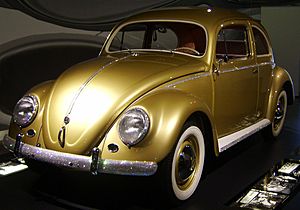
West Germany experienced rapid economic growth from the early 1950s, known as the Wirtschaftswunder (Economic Miracle). Industrial production doubled from 1950 to 1957. Labor unions supported this by agreeing to lower wage increases and promoting modernization.
The recovery was boosted by the currency reform of June 1948, U.S. aid from the Marshall Plan ($1.4 billion), and the opening of global markets. West Germany gained respect and shed its Nazi reputation. It played a central role in European cooperation, joining NATO in 1955 and the European Economic Community in 1958.
1948 Currency Reform
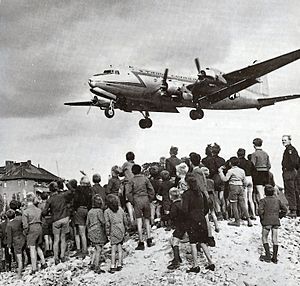
The currency reform of June 21, 1948, was very successful. The old currency was replaced with the new Deutsche Mark at a rate of 1 new for 10 old. This wiped out most debt and savings. Prices were freed, and wages increased. This made German exports competitive and boosted profits. The Marshall Plan funds were used for investment.
The currency reform angered the Soviets, who cut off all links to West Berlin. This led to the Berlin Blockade (June 1948 – May 1949). The U.S. and Britain responded with an airlift of food and coal. West Berlin became economically integrated with West Germany, symbolizing the commitment to freedom.
Konrad Adenauer's Leadership
Konrad Adenauer was West Germany's first Chancellor and leader of the Christian Democratic Union (CDU). Under him, the economy grew fast. He built strong ties with France and the U.S., participated in the European Union, and established the Bundeswehr (armed forces). Adenauer's government also began the process of reconciliation with Jewish people and Israel after the Holocaust.
Ludwig Erhard and the Social Market Economy
Ludwig Erhard was Adenauer's economics minister. His decision to lift price controls in 1948 and his support for free markets helped West Germany's strong growth. Erhard believed in a social market economy, where the market is mostly free but with some social safety nets.
The Social Democratic Party of Germany (SPD) adopted the Godesberg Program in 1959, moving away from Marxism and embracing the market economy and welfare state. Labor unions cooperated more with industry.
Grand Coalition and Ostpolitik
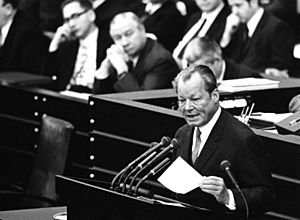
In 1966, a Grand Coalition formed between the CDU/CSU and SPD. Willy Brandt became Deputy Federal Chancellor and Foreign Minister. This government reduced tensions with Soviet bloc nations and established diplomatic relations with Eastern European countries.
Guest Workers Arrive
With a booming economy and a shortage of workers, West Germany signed agreements with Italy, Spain, Greece, and Turkey to bring in temporary guest workers (Gastarbeiter). These were young men who received good wages but were expected to return home. However, many, especially from Turkey, stayed.
Willy Brandt and Ostpolitik
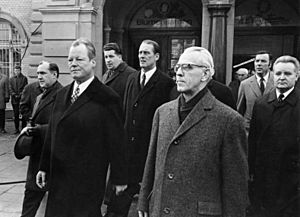
Willy Brandt became West German Chancellor in 1969. He pursued Ostpolitik, a policy to reduce tensions with the Soviet Union and improve relations with East Germany. Relations between the two German states had been very cold. Brandt's policy aimed to ease hardships for divided families.
Ostpolitik was opposed by conservatives but earned Brandt the Nobel Peace Prize in 1971. In September 1973, both West and East Germany joined the United Nations.
Economic Challenges in the 1970s
After 1973, Germany faced a worldwide economic crisis, with high oil prices and unemployment. The Ruhr region, with its coal and steel industries, was hit hard. The welfare system provided a safety net. Factories focused on high-profit items.
A spy scandal forced Brandt to resign as Chancellor. He was replaced by Helmut Schmidt (1974–1982), who continued Ostpolitik but focused more on domestic issues like reducing inflation. Schmidt's government fell in 1982 due to a shift in political alliances.
Helmut Kohl's Leadership
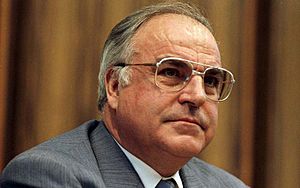
Helmut Kohl brought conservatives back to power in 1982 and served as Chancellor until 1998. He played a key role in German reunification.
Reunification of Germany
During the summer of 1989, rapid changes, known as the peaceful revolution, took place in East Germany. Many East Germans emigrated to West Germany, especially after Hungary opened its borders.
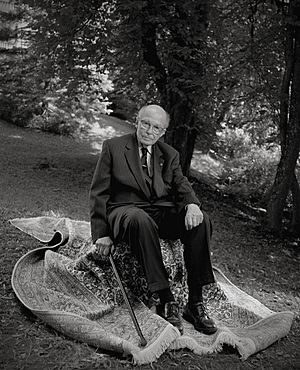
The opening of the Iron Curtain between Austria and Hungary in August 1989 triggered a chain reaction. Thousands of East Germans tried to reach the West through other East European capitals. This exodus led to demands for political change and mass demonstrations in East Germany.
Unable to stop the unrest, Erich Honecker resigned in October. On November 9, East German authorities unexpectedly allowed citizens to enter West Berlin and West Germany. New crossing points opened in the Berlin Wall. This sped up reforms in East Germany, leading to its dissolution and German reunification on October 3, 1990.
Federal Republic of Germany (1990–Present)
Gerhard Schröder's Chancellorship
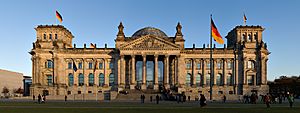
The SPD/Green coalition won the 1998 elections, and Gerhard Schröder became Chancellor. He proposed "Agenda 2010", a plan to reduce the welfare state, cut taxes, and deregulate the labor market.
In December 2004, many Germans died in the 2004 Indian Ocean earthquake and tsunami while on vacation. In 2005, after his party lost an election, Schröder called for new federal elections.
Angela Merkel's Era
In the 2005 elections, Angela Merkel became Germany's first female chancellor. She led a "grand coalition" (CDU/CSU and SPD) for most of her time in office. Major political goals included advancing European integration, the Energiewende (energy transition to sustainable energy), and balanced budgets.
Germany, especially under Chancellor Helmut Kohl, strongly supported admitting many East European countries to the EU. Germany is a leader in creating a more unified European political, defense, and security system. Germany adopted the Euro currency on January 1, 1999.
Since 1990, the German Bundeswehr (armed forces) has participated in peacekeeping and disaster relief missions abroad, including in Afghanistan.
During the Great Recession that began in 2008, Germany did not suffer as much as other European nations. It later provided financial aid during the Eurozone crisis.
After the Fukushima nuclear disaster in Japan in 2011, German public opinion turned against nuclear power in Germany. Merkel announced plans to close nuclear power plants and rely more on wind and other alternative energy sources.
Germany was significantly affected by the European migrant crisis in 2015, receiving over a million refugees and migrants. Merkel's decision to allow unrestricted entry led to criticism and contributed to the rise of the far-right party Alternative for Germany.
The COVID-19 pandemic greatly affected Germany, with many cases and deaths. Germany was initially praised for its response but faced challenges later. Vaccines began in December 2020.
Olaf Scholz's Chancellorship
In September 2021, the Social Democrats (SPD) narrowly won the federal election, ending 16 years of conservative rule. On December 8, 2021, Olaf Scholz was sworn in as Germany's new chancellor, forming a coalition with the Green Party and the Free Democrats.
In February 2022, Frank-Walter Steinmeier was re-elected as Germany's president. After Russia's invasion of Ukraine in February 2022, Germany announced a major shift in policy, pledging a €100 billion fund for the Bundeswehr to strengthen its armed forces.
Images for kids
- Historiography of Germany
- Conservatism in Germany
- Liberalism in Germany
- Economic history of Germany
- History of Berlin
- History of German foreign policy
- History of German journalism
- History of the Jews in Germany
- History of women in Germany
- List of chancellors of Germany
- List of German monarchs
- Family tree of German monarchs
- Military history of Germany
- Names of Germany
- Politics of Germany
- Territorial evolution of Germany
- Timeline of German history
See also
 In Spanish: Historia de Alemania para niños
In Spanish: Historia de Alemania para niños





